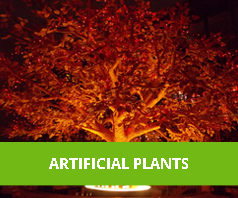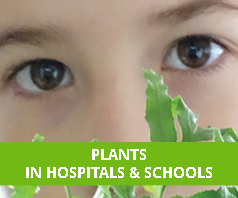
For those that cannot accommodate living plants and trees but would like to add the look and feel of greenery in your building you should consider either artifical or preserved. They are a cost effect alternative to love planting, when issues as very low light levels, insufficient access, weight restrictions or simply ongoing cost implications become prevalent.
Over the years the quality, performance and variety of preserved and artificial has improved considerably and at times distinguishing between live and artificial can be impossible.
They come in a range of materials for both internal and external use. Typically, for interior use, natural tree trunks with wire and resin stems complete with botanically correct foliage are used to give realistic looking indoor trees and shrubs. Plants used for under-planting come without the natural trunks and are constructed to give life-like shaped plants using wire and resin stems with artificial foliage.
Artificial plants can also be designed in colours that nature has not yet mastered, colours which suit your corporate colour scheme and which would have been unattainable through use of real plants. Contact an efig supplier near you to find out if they can provide artificial plants for you here.
Health and Safety
With regards artificial planting, the product can be either sprayed with a fire-retardant solution after manufacturing, which has a very short term quality issue. Alternatively, product can be purchased, which is inherently flame retardant; the flame retardant is added at the manufacturing stage, so the
product remains protected for the plant’s entire life, no respraying is required and cleaning of the product is less difficult.
With the changes in climate conditions around the world a unique product for external use has been developed which uses a polymer material with a UV inhibitor to prevent the product from fading or changing colour over a period of time. In the very near future a UV, inherently flame retardant foliage will be available, for those highly populated public areas
Preserved material
For the next best thing to live plants, you should consider using preserved. It is only available in a few lines, but provides a truly realistic, flexible, unique and practical solution to live planting. Preserved foliage is harvested from sustainably grown plants before going through a systemic process where the natural fluids of the leaf drain and it absorbs the proprietary non toxic, fire retardant chemical to preserve the leaf. From the early years of Glycerine based solution, preserved is now far different in performance and is now humidity tolerant and fade resistant.
This fact sheet explains how artificial plants are made and gives advice on how to specify them.
Manufacture
Artificial trees can be made on real wood, Cocoa or Bamboo stems. They are either imported ready made from the Far East or made in the UK with imported foliage.
Imported Trees
- These have a standard leaf count and tend to be consistent in size and shape.
- They are usually cheaper then British made trees but can be of variable quality.
British-made trees
- These trees are made to order, so it is possible to specify an exact height, shape and leaf count.
- Most are built on ash trunks which are coated in preservative, drilled and the foliage is hot glued into place.
- Smaller trees will be concreted into plastic pots whereas larger trees are supplied in individual trunks, which are bolted into place on site.
Bush and Trailing Vines
- Smaller plants and trailing vines come in a multitude of shapes, sizes and colours. Used as a base plant they can add colour and interest.
- A high level vine can range from 300 to over 1800mm as single vines or bushes.
Flame-retardant
Untreated, artificial foliage is flammable. It can be flame retarded in two ways:
Inherent
- The foliage is impregnated with flame retardant during the manufacturing process
- This protects both the foliage and the plastic to BS 5438
- Many of the tree foliages are now available in inherent but the range of base plants is still limited
- Where possible this is preferable.
Sprayed Foliage
- Non-inherent foliage can be treated with flame retardant chemicals. This is applied with a hand spray by a contractor or specialist
- In schemes with in situ planting, treatment is normally done on-site. It is important to note that, as the flame retardant is water-soluble, the planting should thereafter be dry dusted or cleaned by a specialist.
- Protection should be specified to BS 5867 & BS 5438.
Maintenance
Regular maintenance is essential not only keep the plants looking fresh but also to extend the life of the scheme. Frequency of cleaning will depend on location; planting in public places and entrances may need cleaning every 2 to 3 months, in offices 6 monthly may suffice. Your contractor will advise on a suitable programme.
If the plants have been sprayed with flame retardant, the cleaning chemical should incorporate flame retardant to ensure the certification is maintained.
Specifying Artificial Planting
If you have to draw up a specification for an artificial planting scheme the following points may be helpful.
If the trees are made to order you can specify
- Overall height
- Diameter of canopy (on a standard tree this would be half of overall height)
- Shape of canopy
- Leaf count ( most manufacturers will have standard leaf count for their trees which can be increased or decreased to suit the style of tree required)
- Inherent or non inherently fire-rated foliage
Free-standing Displays
- Displays can be simple specimens or have underplanting.
- The quality of specimens varies considerably from “promotional” trees which generally have a low leaf count to a purpose made British trees. Consider which is most appropriate for the scheme. Ask for a sample if necessary
- The top dressing on a display is normally a clay pebble (LECA). In public areas, it is advisable to have this bonded
- High Level
- Consider the length and density of trail required and height of any upright plants. Planting is usually in polystyrene blocks, which may be set into decorative containers or simply left bare. On large schemes, most contractors would expect to provide sample plantings
Contact a plants@work supplier near you to find out if they can provide artificial plants for you through our Regional Contractor Lists.









